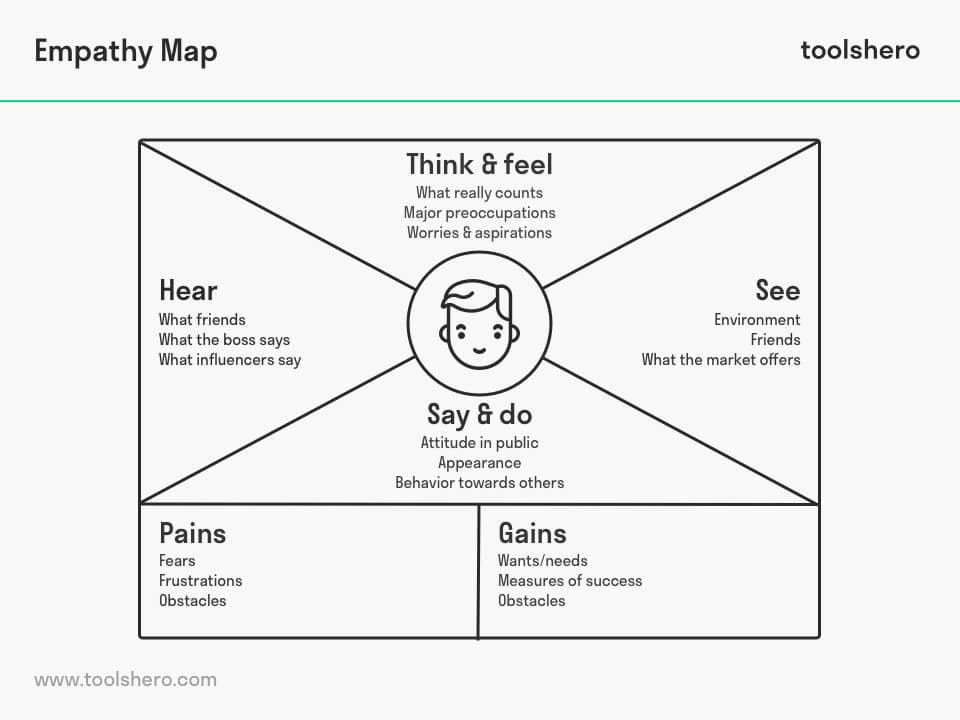Empathy Map explained plus template

Empathy Map: this article provides a practical explanation of the Empathy Map. Next to what it is (theory and acronym including examples), this article also highlights a step by step guide, an empathy map template to get started and tips. After reading, you’ll understand the basics of this marketing tool. Enjoy Reading!
What is an Empathy Map?
Definition of an Empathy Map
An Empathy Map is a tool that’s used for collecting customer data from user research in order to understand the target audience better. There are many different techniques that are used to manage this kind of empathy. The Empathy Map is just one of those. With the map, customer data is summarised in a visualisation that consists of four quadrants.
These four quadrants each describe a different main trait of the user. An Empathy Map is developed based on results that are obtained from an observation or research phase. The four quadrants refer to what a user says, does, thinks, or feels: user’s behaviors. This is the start of the design thinking process.
Determining what consumers say is easy, but determining what they think and feel has to be based on careful observations and behavioural analyses in order to discover how they act and how they respond to various activities, suggestions, topics, etc.
An Empathy Map is especially useful at the start of the design phase of a product, but before production requirements are set.
The mapping process can help with getting deeper insights into the needs of users. The maps are most reliable when they are based on research data, but can also be created based on knowledge from internal participants or previously created marketing user personas.
To summarise the advantages of using an Empathy Map:
- Better understanding of the end user
- Important information summarised in a clear visualisation
- Highlights of the most important insights from research are explained
- It’s quick and cheap to use; easy to adapt

Figure 1 – Empathy Map Example
Step-by-step plan for filling out & using an Empathy Map
Empathy Maps come in different formats, but they generally have a common set of core elements. A big, white sheet of paper is the basis. It is divided into various sections around the central point: the end user. As the example image and the downloadable template show, the visualisation of the user is often a big, empty head.
Each section is labelled. This represents the category of the external observable environment of the user. The internal state of mind of the user is also included; what he does, sees, hears, thinks, and feels. In addition, there are the elements of pain and profit.
An Empathy Map is usually filled out by a marketing team. Follow the step-by-step plan below to create your own Empathy Map.
Step 1: determining the goals for the Empathy Map
The first important thing is for the team members and makers of the Empathy Map to decide who to put in the centre of it. This is the user who they’re trying to get a better understanding of.
As mentioned, the basis for this is data from the customer files, but existing personas will also suffice. If these maps are made for multiple personas, each persona gets its own map.
This instrument revolves around building empathy, allowing organisations to better understand their consumers and adjust their business activities accordingly. The goal of making an EM is therefore not to sell or design a product, but it helps to answer certain questions in advance, such as:
- What is the desired result of this map?
- When can we call the representation of a persona successful?
- What should the persona do or decide differently? What behaviour is desired or normal?
Step 2: study the persona’s internal world
When step 1 is completed, it’s time to document the persona’s interior world. In order to be able to do this well, it is important to study the experiences of the end user. It is important that this Empathy Map is filled out from the perspective of the end user. Keep this in mind.
Fill out the sections of the Empathy Map to determine what the end user is thinking, feeling, seeing, saying, doing, and hearing. Use sticky notes or any other choice of method.
What do the users think and feel?
In this section, it’s about the following matters:
- What is truly important to the end user
- Concerns of the end user
- Aspirations of the end user
Consider both positive and negative sides of the end user’s thoughts. Why is the user feeling well? Or why bad? Also research characteristic aspects of the user’s pains and profits. Explain why there are certain frustrations, or which obstacles get in the way. What are the end user’s goals and dreams?
Step 3: study the end user’s external world
After step 2, start determining the end user’s external world. Start by researching the user’s experience and imagine what it’s like to be him or her. After that, fill out the various sections of the Empathy Map in order to determine what they’re seeing, saying, doing, and hearing.
What do the users see?
This section is about the following:
- What does the end user’s environment look like?
- What does the end user’s circle of friends look like?
- What does the market offer our end users?
What the users see is related to the end user’s day-to-day experiences. These can be people, things, or activities. What do these people do? What happens on an average day? How does the user come into contact with the market in which we operate? Consider competition, alternative products or services. Remember that it’s about the end user’s world, not yours.
What do the users say and do?
In this section, it’s important to think about the following matters:
- What is the end user’s attitude? Specific behaviour?
- How does the end user come across? (appearance)
- How does the end user behave? And towards others?
What the users say and do is about behaviour and the way they interact with the world around them. This can change depending on where they are or with whom they are. Also include why the end user’s behaviour might change, for instance in response to events or developments.
What do the users hear?
In this section, focus on the following aspects:
- What do the end user’s friends say?
- What do other influential people say? Such as family? Clients?
- Who influences the end users and how?
The final section is about what the end users hear, and how this affects them. Take both personal and professional connections into consideration, such as friends, colleagues, partners, or other acquaintances. Additionally, consider what the user is exposed to on social media, for instance influencers or bloggers.
Step 4: summarise
Take a moment to reflect when all sections are complete. Let different people have a look at the map and offer their opinions on the experience. Ask them if it has given them any new insights, if they would like to add something, or if they have a new perspective now.
Hang the Empathy Map in the cafeteria or another public area. This is a great way to give others in the organisation a chance to see the map and build their empathy toward the customer or persona.
The Empathy Map will not lead to a shift when it comes to the focus on the end user, but the goal of this instrument is to put the focus on the user. This is a way to do that.
Step 5: revise and finish
If things have gone according to plan, there will now be different versions of the map, and several forms of feedback will have been received. Choose a final map from the different versions. Look for patterns between different persons, such as multiple people talking about similar experiences.
A clear and effective Empathy Map is not overburdened with text. Make sure the map is clear, concise, and easy to scan. Even if it’s possible to put 40 items on the map, it’s better to go for a top 10.
When an accurate and clear map has been created for each customer profile, the bulk of the work is done. Use the Empathy Maps when, for example, considering new products or services, marketing materials, etc.
Empathy Map template
Now that you have read about the Empathy Map, you can put the knowledge into practice. Get started with this editable Empathy Map template and learn to understand your target group better.
Download the Empathy Map template
This template is exclusively for our paying Toolshero members. Click here to see if a membership is something for you!Tips for creating an Empathy Map
Tip 1: don’t fret about what goes where on an Empathy Map
It doesn’t matter where exactly you show what on the Empathy Map. Some people might be worried that not everything is in the right spot.
For instance, isn’t this a pain or different feeling? Did they see or hear this? It’s okay if a certain feeling or different aspect is listed in the wrong category. The goal is not to categorise all the information correctly; it’s about associating things with the end user.
Tip 2: only study important issues
Only consider perceptions of the end user that are relevant to the purposes of the Empathy Map. This tool isn’t just about recording emotional behaviour aspects of the user; it’s about focusing on the end user and understanding the world around them in relation to the business.
So don’t include all kinds of superficial matters, such as liking a certain artist (unless this has a big impact on the user’s lifestyle). Information that’s too broad, can give a marketing team the wrong idea.
Tip 3: don’t be afraid to alter the map
Adjust or streamline the different elements of the Empathy Map if needed. Work on optimising the persona and other available data.
For instance, if the subject is a manager of a B2B business, personal feelings are probably less relevant. This manager has to work with the possibilities of the organisation within a certain bandwidth of decision-making authority.
Make the necessary changes to the map to ensure its result is accurate and useful. Only then will the activity of creating Empathy Maps be productive and useful.
Empathy Map summary
An Empathy Map is a graphical representation of the internal and external world of an end user. The tool is mainly employed by marketeers and helps with better understanding the target audience. The map is divided into different quadrants. These each represent another element in the user’s interior or exterior world.
Firstly it’s important to write down the goals of the Empathy Map. What’s the desired result? And when can the designing of such maps be considered successful?
Step two is about the persona’s interior world. This is about what they’re thinking and feeling. Consider what’s important to them, what concerns they may have, and what their aspirations are. This is often studied by user interviews.
The third step is studying the end user’s external world. This strongly influences people. Who do they see? And what do they say and do? Finally note down what they hear.
In the fourth step, it’s all summarised and optimised in a mapping session. Based on a complete set of Empathy Maps for different personas, future decisions can be made about product designs or other marketing ideas.
The advantages of an Empathy Map are legion. For instance, it helps to provide a better understanding of the end user, making it possible to offer better products and services. In the end it’s about serving consumers as well as possible, so it can make or break an organisation in terms of performance and competition.
On top of that, the Empathy Map can serve as a good summary of the different personas that have been created by the marketing team. The map is easy to create and even easier to adjust.
Now it’s your turn
What do you think? Are you familiar with the the explanation of the Empathy Map? Have you ever created an Empathy Map? Or a marketing persona? Do you think it’s useful to explore the end user from the perspective of a marketing team? What do you think is the added value of an Empathy Map? Have you signed up for toolshero yet, and will you be downloading and using the available template? Tell us about your experiences in the comments section below.
Share your experience and knowledge in the comments box below.
More information
- Bratsberg, H. M. (2012). Empathy maps of the foursight preferences.
- Ferreira, B., Conte, T., & Barbosa, S. D. J. (2015, September). Eliciting requirements using personas and empathy map to enhance the user experience. In 2015 29th Brazilian Symposium on Software Engineering (pp. 80-89). IEEE.
- Ferreira, B., Silva, W., Oliveira Jr, E. A., & Conte, T. (2015, May). Designing Personas with Empathy Map. In SEKE (Vol. 152).
- Rosenbaum, M. S., Otalora, M. L., & Ramírez, G. C. (2017). How to create a realistic customer journey map. Business Horizons, 60(1), 143-150.
How to cite this article:
Janse, B. (2020). Empathy Map. Retrieved [insert date] from Toolshero: https://www.toolshero.com/marketing/empathy-map/
Original publication date: 04/05/2020 | Last update: 09/08/2023
Add a link to this page on your website:
<a href=”https://www.toolshero.com/marketing/empathy-map/”>Toolshero: Empathy Map</a>












